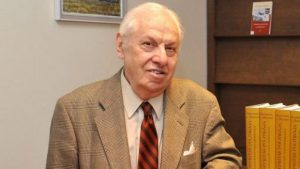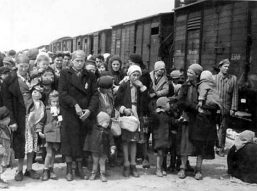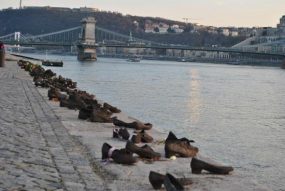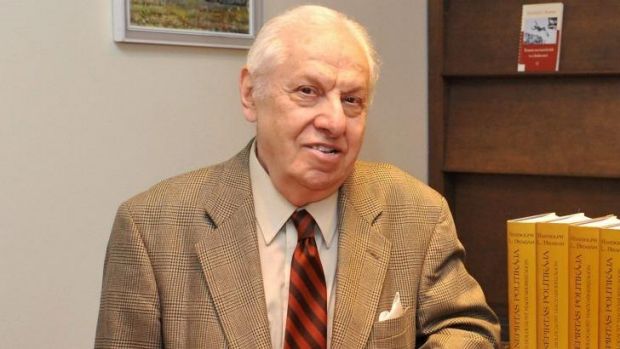In Memoriam: Randolph Braham, 1922-2018

I first encountered Randolph Braham by accident. In my early thirties, I lived on West 97th Street in Manhattan, and on weekends I often went for walks down Broadway just to enjoy the sites and browse in the stores. Fall was the best time, when the low midday sun warmed my face and drew vivid shadows around the buildings, the street trees, and the people, and heightening the sense of being alive.
One Sunday, I wandered into West Side Judaica with a vague sense that they might have some books on Jewish history. A few weeks earlier, on a stroll with my grandmother through Central Park, I had learned that some thirty members of my family had been lost in the Holocaust. It was the first time she had spoken of those people and that horror. In the Judaica store, I walked over to the wall of books, located the history area, and scanned the titles. The Six Day War, biographies, the founding of Israel were all mixed together, arranged by some idiosyncratic scheme I could not decipher. I noticed an older woman in a plain skirt and a dark blouse sorting a pile of paperbacks. She looked up.
“Hungary,” I said, gesturing toward the shelves. “I am wondering whether you might have anything on the Holocaust in Hungary.”
I sensed a brief break in the chatter at the register behind me between the two men in white shirts, skull caps, and payot who had greeted me in friendly yet impersonal tones as I entered. I started to sweat and unzipped my coat and fleece.
‘What Sort of Catastrophe?’
“A few,” the woman said, without inflection. She led me to an uneven row of volumes maybe ten inches apart. As I scanned the books, my eyes settled quickly on a faded white book jacket, a little bent and torn at the top. The title on the binding read, The Hungarian Jewish Catastrophe. The choice of words intrigued me. Catastrophe. The term was large and dreadful, but also grounded and alive. It was vague, evasive even. ‘What sort of catastrophe?’ I thought wryly as I pulled the book from the shelf. On the title page I found the name of the editor, Randolph Braham. The contents told me it was a bibliography, and I flipped quickly through pages and pages filled with hundreds of sources. I vowed to read them all, then deflated at the price-sticker on the back. Though it was not a small proportion of the money I had left each month after rent and school-debt payments, I bought it anyway.
Something in me was not ready, however, and the book gathered dust in my bookcase. It was not until a few years later that the urge to know strengthened again and, with time before a lecture I was to see there, I found myself wandering into the library of the 92nd Street Y. On a shelf in the stacks, they Braham’s great work, The Politics of Genocide: The Holocaust in Hungary. As I had learned from the jacket of the bibliography, Braham, a professor at the City University of New York’s Graduate Center, had survived the Holocaust in Hungary and had spent a lifetime chronicling its political and operational aspects in minute detail. I pulled down Volume 1, sat on a shelving stool, opened to the Preface, and so was introduced for real to Braham and his inimitable style – meticulous, erudite, direct and with a voice that was a striking combination of matter-of-factness and outrage. Here was a man so clear-minded, so steeped in the context, in the specifics, that he could distill the essentials of the Holocaust in Hungary in three sentences:
“Uninformed, unprepared, and basically disunited, Hungarian Jewry consequently became easy prey for the SS and their Hungarian accomplices after the occupation. The Final Solution program – the isolation, expropriation, ghettoization, concentration, and deportation of the Jews – was carried out at lightning speed. In late spring 1944, close to 440,000 Jews from all over Hungary, excepting Budapest, were deported to Auschwitz within less than two months.”

Fragments Set Into A Frame
Through Braham, I learned more about “from all over Hungary,” in particular, Nagykanizsa, from where treasured cousins of my grandmother’s, along with their children, had been sent to their deaths in Auschwitz. Through Braham, I delved deeply into “excepting Budapest,” and slowly pieced together our family survival story – by setting fragments of recollections from my grandmother, my father, my aunt, into the frame of Braham’s detailed and expansive history of how most of Budapest’s Jews survived. Through Braham, I learned about Labor Service, from which one great uncle returned, and another did not. Through Braham I learned about the complexity of the position of Hungary’s leaders toward the Jews – understanding finally how my grandfather, an officer in the Austro-Hungarian Army in World War I who spent six years in a Russian prisoner-of-war camp, was still running a wholesale denim business in downtown Pest in the spring of 1943, when he died suddenly of a brain hemorrhage. I learned about Hungary’s complicity, too. Through Braham, I learned about Eichmann’s return, ghettoization of the Jews, and the death marches west that ended for many in death at Mauthausen (which claimed a cousin’s parents when she was just a girl) or by the side of the road along the way. Through Braham, I came to understand the murderous environment my immediate family somehow survived: savage Arrow-Cross gangs, vicious and unbelievably destructive block-to-block fighting between the German and Russian armies, the chaos of the immediate aftermath of Soviet occupation.

Through Braham, I came to assemble and take hold of a large part of my identity, which, until I read and reflected on his great work, had resided, split and silenced, in darkness deep within me. This enabled me to write a memoir about my relationship with my Hungarian grandmother, and the development of my identity, Finding Maria. And yet, there was a problem. Toward the end of my book, I developed scenes where I was reading the Budapest sections of The Politics of Genocide. To do this, I included several extended quotes from Braham. As the book neared publication, my publisher, editor, and I discussed whether permission was needed from Braham to reprint the quotes. We decided that the right thing to do was to ask him for it.
I had no back-up plan for how I would revise this crucial part of the book if he refused, so it was with some trepidation that I found Braham’s email address and sent him a note with my request. He responded within a day with his permission and wishes for good luck on publication. He asked to see a copy of the book when it was published, and in the course of an email exchange soon after the book came out in the spring of 2017 – asking for his address, confirming he had received the book – he invited me to be his guest at lunch at the Graduate Center.
‘Maybe next time in Jerusalem!’
He greeted me at his office door, dressed in black, his dark eyes alight with passion. He led me to the cafeteria and over lunch we discussed how he had gone about his work, how my book had been received, the increasing difficulty he found in making his way into Manhattan, and his disappointment with the direction the government of Hungary had taken in recent years in regards to Hungary’s role in the Holocaust, and many other areas. He invited me to dine again someday. “Maybe next time in Jerusalem!” he said with a laugh. As we passed a wall that listed CUNY benefactors, he pointed proudly to his name and told me how he had donated the profits from his work to the school.
I was grateful to have met him. I was grateful for his encouragement. I remain grateful for his work, which has left the world a legacy of fine-grained truth through which we may reconcile, rework, and renew ourselves for many generations to come.
Photo credits:
(1) Randolph Braham, by The Associated Press
(2) Arrival of Hungarian Jews at Auschwitz-Birkenau, from
https://www.scrapbookpages.com/AuschwitzScrapbook/History/Articles/HungarianJews.html
(3) Shoes-on-the-Danube meorial of the murdered, by Bild von Schuhe am Donauufer, tripAdvisor.de

